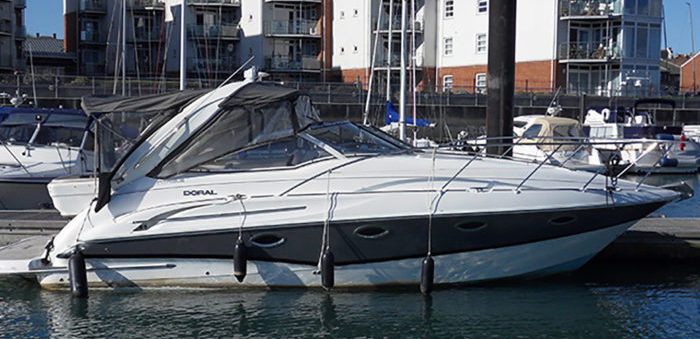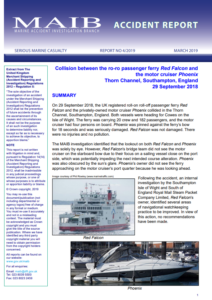UK MAIB published its report on the collision between the ro-ro passenger ferry Red Falcon and the motor cruiser Phoenix, at Thorn Channel, Southampton, UK, on 29 September 2018. According to the report, the effectiveness of the lookout on board Red Falcon’s bridge was reduced as the master and chief officer were seated and the bridge window sun screens were not lowered.
The incident
On 29 September 2018, the ro-ro passenger ferry Red Falcon left Southampton with 182 passengers on board for a routine crossing to East Cowes, Isle of Wight. On the bridge were the master, who had the conn, and a deckhand, who was steering the vessel and controlling the speed.
[smlsubform prepend=”GET THE SAFETY4SEA IN YOUR INBOX!” showname=false emailtxt=”” emailholder=”Enter your email address” showsubmit=true submittxt=”Submit” jsthanks=false thankyou=”Thank you for subscribing to our mailing list”]
In the meantime, the 10m motor cruiser Phoenix departed Hamble, Hampshire, with its owner at the helm accompanied by three adults. The motor cruiser was also bound for Cowes. It was a clear, bright sunny day with a light easterly wind and good visibility.
At 16.27, Red Falcon’s master called Southampton VTS2 on VHF3 channel 12 to advise that the ferry was passing the Hook buoy. Meanwhile, the chief officer took over from the deckhand, and sat down behind the central propulsion control console. The master was seated on the starboard side of the bridge.
At that time, Phoenix had crossed the main channel and was southbound to the west of Castle Point buoy. VTS radar tracking, which was intermittent, indicated that the motor cruiser’s speed was briefly reduced at some point, leading in an average speed of 6kts for the period.
When Red Falcon passed to the east of Castle Point buoy, an unknown motor cruiser passed down the ferry’s starboard side. A little later, the ferry started a slow turn to starboard into the Thorn Channel.
During the turn, the master and chief officer discussed the fine weather and some small slow-moving recreational craft on the Calshot Spit Bank to the west of the channel. None of these vessels were assessed to be a potential problem. At the time, Phoenix was southbound to the west of the Calshot Spit light float.
Phoenix entered the Thorn Channel and its skipper was at the helm looking ahead, while one of the passengers was seated on the port side of the cockpit facing the skipper and the two remaining passengers were in the cabin below.
At 16.34, Red Falcon’s chief officer steadied the ferry in the Thorn Channel. The bright sun was now about 25° off the starboard bow with significant glare being reflected off the water. However, the master, who was using sun shades over prescription glasses, intended that the ferry continue on this heading for only a very short period before turning to the south to pass west of the North Thorn buoy.
He and the chief officer, both of whom remained seated, were aware of a yacht on the port bow and decided not to turn to the south before the yacht was sufficiently clear down the ferry’s port side.
At 16.35 Red Falcon started to turn to port, when seconds later, the starboard side of the ferry’s bow collided with Phoenix’s port side. The motor cruiser was pinned against the ferry’s bow for about 18 seconds during which time it was pushed over to starboard to an angle of approximately 40°.
Probable cause
As UK MAIB noted that following contributed to the collision of the two vessels”
- The lookout on both Red Falcon and Phoenix was solely by eye;
- Red Falcon’s bridge team did not see the motor cruiser on the starboard bow due to Phoenix being obscured by the sun’s glare and window frame blind arcs;
- The effectiveness of the lookout maintained on board Red Falcon’s bridge was reduced because the master and chief officer remained seated and the bridge window sun screens were not lowered;
- Phoenix’s owner had limited knowledge of the COLREGs and local guidance, and did not check astern when entering the Thorn Channel at a shallow angle.
Recommendations
After the incident, an internal investigation by the Southampton Isle of Wight and South of England Royal Mail Steam Packet Company Limited (Red Funnel), Red Falcon’s owner, identified numerous areas of navigational watchkeeping practice to be improved. In view of this action, no recommendations were made.
See more information into the accident, in the PDF below































































